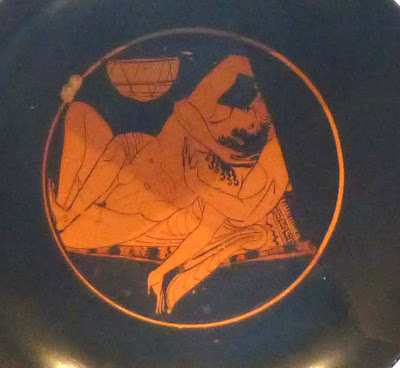Jaharis Gallery of Greek, Roman, and Byzantine Art
Thanks to a Greek-American pharmaceutical billionaire, both the Metropolitan Museum and the Art Institute of Chicago have new galleries of Greco-Roman art. The one in Chicago is 4X the size of the previous display - most of that additional space being taken by loans from private collectors and other museums - including the British Museum which sent the bizarre Lycurgus Cup (Rome, 4th C. AD) that turns red when light is passed through it.
Lycurgus is the poor devil who was punished for dis-respecting Bacchus -- so one assumes that cup was filled with wine and the guest was challenged to quaff it all or else.
It's rough figures would definitely contribute to a party-ho ambiance.
This is the Tyche of Antioch
And this is the accompanying Tyche of Rome. They are part of the Esquiline Treasure, dug up in 1793 at the foot of the Esquiline hill, and dating back to the fourth century.
Also from the Esquiline treasure is the Muses Casket
... and the Projecta Casket that shows both Christian and pagan iconography.
Here's an ivory pyxis (box) from 6th C. Egypt depicting the martyrdom of St. Menas.
Here's a famous piece that recently went on the market as a piece once owned by Lorenzo Di Medici.
Here's the fallen figure from Pollaiolo's "Battle of the Nudes" that allegedly was derived from it.
And here's a figure from Michelangelo's youthful "Battle of the Centaurs" that also has been connected to it.
Silver plate with satyr and dancing Maenad, Constantinople, C. 570
Silver plate with Venus, Cupid, and Psyche, Constantinople, C. 400
These two silver plates have recently entered the A.I.C. collection -- and their low relief looks much better in person.
This show has pulled many painted Greek ceramics up from storage - but mostly their value is historic.
This erotic scene from the Getty, however, has a little more energy
While searching for it on the internet, I stumbled upon this magnificent scene, c. 500 bc, from the Museum of Fine Arts, Boston.
Wow! It's exactly the kind of dramatic stylization my father would have dreamed up 2500 years later.
Too bad it wasn't loaned to Chicago.
Here's the other painting that I liked - said to come from the Athenian workshop of Nikosthenes 530-520 BC. It's another anonymous loan, so we may never see it again.
But this Etruscan piece, one of my favorites, is from the permanent collection, and I've been enjoying it for decades.
Finally, thanks to an anonymous loan, there's two more Egyptian portraits on display. Why is this Roman era portraiture so compelling ?



















1 Comments:
Satisfying visit! I find those faiyum compelling, too--those usually wide eyes in a face not quite frontal, as though just turned to look one in the face.
Post a Comment
<< Home